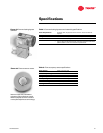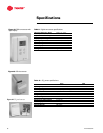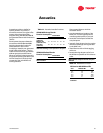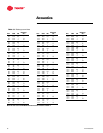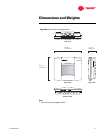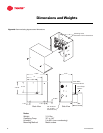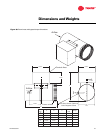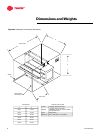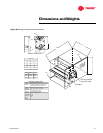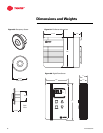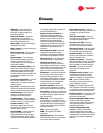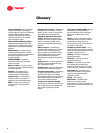
VAV-PRC003-EN 47
Glossary
ABS gears – Gears formed of a
lightweight plastic known for its
toughness, impact strength, and
dimensional stability.
Back draft damper – A one-way
airflow damper in a parallel fan
powered unit prevents primary flow
from exiting the plenem inlet.
Binary input – A two-position signal
indicating on/off status.
Binary output – A control output that
is either on or off.
Built-in time clock – The occupancy
timer included in the CCP operator
display.
Bypass damper – The motorized
damper ducted between the system
supply and return ducts used to
control static pressure in changeover
bypass VAV systems.
Central control panel (CCP) – The
system level control device in a Trane
changeover bypass or delivered VAV
system that gathers data from zone
controllers and operates the HVAC unit
to maintain the correct air flow and
temperature.
Changeover-bypass VAV – A control
that provides variable air volume
functionality to a constant volume air
handling system.
CO
2
sensor – An analog sensor that
detects and measures carbon dioxide
sensor to determine occupancy level.
Commissioning – The process of
starting up and verifying correct
operation of a building system.
Conditioned air – Air that is heated,
cooled, humidified, or dehumidified to
maintain comfort in an interior space.
Constant volume – An air
distribution system that varies the
temperature of a fixed volume of air to
maintain space comfort.
Delivered VAV – A self configuring
system providing true pressure
independent VAV control to smaller
building applications. Delivered VAV
requires a CCP with operator display, a
Commercial Voyager VAV rooftop unit
and VariTrane VAV boxes.
Demand control ventilation – A
method of maintaining indoor air
quality through intelligent ventilation
based on occupancy. The quantity of
ventilation is controlled based on
indoor CO2 levels, which correlate to
occupancy levels. Demand controlled
ventilation saves money by reducing
ventilation during periods of low
occupancy.
Direct-expansion (DX) – When the
refrigerant in the system is either
condensed or evaporated directly by
the medium being heated or cooled.
Discharge air (DA) – Air discharged
from the air handler into the ducts.
Discharge air control – An air
handling system that provides fixed
temperature air (either fixed or variable
volume). Other control devices vary the
actual volume of air delivered to the
space to maintain occupant comfort.
Economizer – A damper arrangement
and automatic control system that
allows a heating, ventilation and air
conditioning (HVAC) system to supply
up to 100 percent outside air to satisfy
cooling demands, even if additional
mechanical cooling is required
Exception schedule – A one time
only time of day schedule in a system
that is removed automatically after use
Free cooling – Outdoor air introduced
to a system under correct conditions to
provided cooling to a space. Also see
also “Economizer”
HVAC Unit – An air moving device
that conditions air. An HVAC unit may
provide cooling, or heating and cooling.
Typical HVAC units include packaged
rooftop units, split systems, and water
source heat pumps.
LCD – Liquid crystal display
NDIR – Non-dispersive infrared
technology
Negative pressure – The condition
that exists when more air is exhausted
from a space than is supplied.
Non-volatile memory – System
memory that retains programming with
no battery or capacitor back up
required
Normally closed (NC) – Electrical
contacts that are closed (current flows)
in the de-energized condition
Normally open (NO) – Electrical
contacts that are open (no current
flows) in the de-energized condition
Occupancy sensor – A binary sensor
that transmits a signal upon detection
of movement in the coverage area
Outdoor air (OA) – This is fresh air
drawn in to provide space ventilation.
Also see ‘Ventilation air”
Outdoor air damper – The damper
that draws fresh air into the air handling
system for ventilation. Also referred to
as the ventilation or fresh air damper
Override – A manual or automatic
action taken to bypass normal
operation
Packaged unitary system – An air
handling system with all the major
components contained in a single
cabinet or installed in a single location
PIR – Passive infrared sensing
technology (used in occupancy and
motion detection sensors)
Polling – The method a VariTrac CCP
uses to determine the need for heating
or cooling from the air handling system
by examining the zone requirements
Positive pressure – The condition that
exists when more air is supplied to a
space than is exhausted.
Pressure-dependent VAV control –
A VAV unit with airflow quantity
dependent upon static pressure. There
is no zone flow sensor in pressure
dependent VAV boxes.
Pressure-independent VAV
control – A VAV unit with airflow
quantity independent of duct static
pressure. Actual airflow to the space is
measured and controlled by an airflow
sensor in the pressure independent
VAV box.



